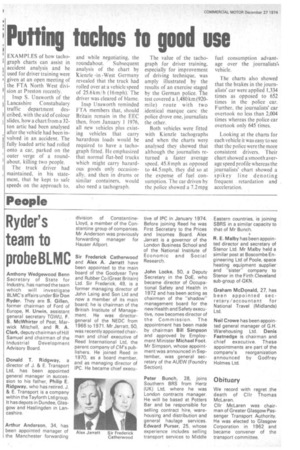Putting tachos to good use
Page 10

If you've noticed an error in this article please click here to report it so we can fix it.
EXAMPLES of how tachograph charts can assist in accident analysis and he • , used for driver training were given at an open meeting of the FTA North West division at Preston recently.
Insp S. Unsworth of the Lancashire Constabulary traffic department described. with the aid of colour slides, how a chart from a 32ton artic had been analysed after the vehicle had been involved in an accident. The fully loaded artic had rolled onto a car, parked on the outer verge of a roundabout, killing two people.
I The truck driver had maintained, in his state ment. that he kept to safe speeds on the approach to, and while negotiating, the roundabout. Subsequent analysis of the chart by k ienzle sin !West Germany revealed that the truck had rolled over at a vehicle speed of 25.6 km/ h (16mph). The driver was cleared of blame.
Insp Unsworth reminded FTA members that, should Britain remain in the EEC then, from January 1 1976, all new vehicles plus existing vehicles that carry hazardous loads would be required to have a tachograph fitted. He emphasized that normal flat-bed trucks which might carry hazardous goods only occasionally, and then in drums or similar containers, would also need a tachograph. The value of the tachograph for driver training, especially for improvement of driving technique, was amply illustrated by the results of an exercise staged by the German police. The test covered a 1,480 km (920mile) route with two identical marque cars: the police drove one, journalists the other.
Both vehicles were fitted with Kienzle tachographs and when the charts were analysed they showed that although the journalists returned a faster average speed, 45.8 mph as opposed to 44.5 mph, they did so at the expense of fuel consumption. The car driven by the police showed a 7.2 mpg fuel consumption advantage over the journalists% vehicle.
The charts also showed that the brakes in the journalists' car were applied 1,334 times as opposed to 652 times in the police car. Further, the journalists' car overtook no less than 2,004 times whereas the police car overtook only 645 times.
Looking at the charts for each vehicle it was easy to see that the police were the more consistent drivers. Their chart showed a smooth average speed profile whereas the journalists' chart showed a spikes' line denoting frequent retardation and acceleration.




































































